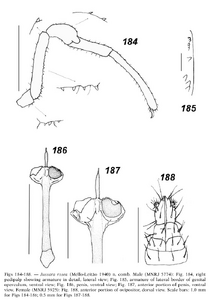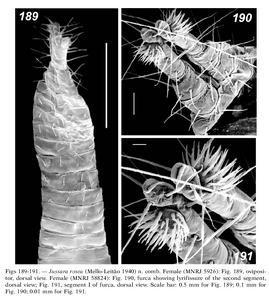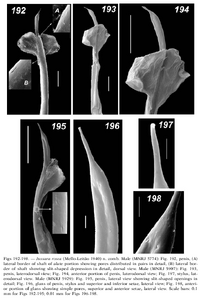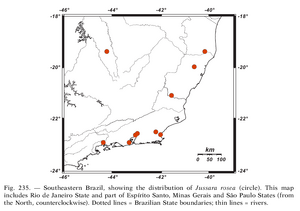| Jussara rosea | |
|---|---|
 Jussara rosea (Mello-Leitão, 1940) (from Tourinho & Kury, 2003) | |
|
Suborder |
|
|
Superfamily |
|
|
Family |
|
|
Subfamily |
|
|
Genus |
|
Jussara rosea (Mello-Leitão, 1940) is a member of the genus Jussara (Eupnoi:Sclerosomatidae).
Taxonomy[]
- Holcobunus roseus Mello-Leitão, 1940:96
- J.r. Tourinho & Kury, 2003:254
Specimens[]
- H.r. male(1) (holotype) Museu Nacional/UFRJ; #133
- J.r. male(1) Museu Nacional/UFRJ; #5929
- J.r. female(1) Museu Nacional/UFRJ; #5930
- J.r. male(1) Museu Nacional/UFRJ; #5908
- J.r. male(1) Museu Nacional/UFRJ; #6402
- J.r. male(1) Museu Nacional/UFRJ; #58821
- J.r. female(1) Museu Nacional/UFRJ; #58822
- J.r. female(1) Museu Nacional/UFRJ; #58823
- J.r. female(1) Museu Nacional/UFRJ; #58824
- J.r. male(1) Museu Nacional/UFRJ; #5907
- J.r. male(1) Museu Nacional/UFRJ; #58825
- J.r. female(5) Museu Nacional/UFRJ; #5904
- J.r. female(1) Museu Nacional/UFRJ; #6705
- J.r. female(1) Museu Nacional/UFRJ; #5906
- J.r. male(1) Museu Nacional/UFRJ; #6902
- J.r. female(3) Museu Nacional/UFRJ; #5774
- J.r. male(5) Museu Nacional/UFRJ; #6852
- J.r. female(1) Museu Nacional/UFRJ; #6162
- J.r. male(4) + female(1) Museu Nacional/UFRJ; #58843
- J.r. male(1) Museu Nacional/UFRJ; #5925
- J.r. female(5) Museu Nacional/UFRJ; #5926
- J.r. female(1) Museu Nacional/UFRJ; #5927
Diagnosis[]
(from Tourinho & Kury, 2003)
Body and trochanters of legs II yellowish orange or pale yellow (for specimens in alcohol). Eye mound and legs including trochanters I, IIIIV black, chelicerae and pedipalps yellowish-orange or pale yellow (for species in alcohol) (Figs 177-181). Posterior half of winglets rounded (Figs 187, 192).
Description[]
(from Tourinho & Kury, 2003)
Male[]
- Measurements. Body 4.4 mm, carapace 1.2 mm, dorsal scute 2.8 mm, chelicera 1.7 mm, pedipalps 5.8 mm, penis 1.9 mm.
- Colour. Ventral surface and coxae yellowish orange or pale yellow (Figs 177-179).
- Dorsal surface. Surface of the body densely granular. Supracheliceral laminae distally armed with blunt granules (Fig. 182). Eye mound armed with two rows of sharp-pointed granules.
- Ventral surface. Lateral borders of the genital operculum armed with blunt granules with one to three points (Fig. 187), arculi genitales III unarmed.
- Chelicera. Ventrobasal spine of basichelicerite sharp-pointed (Fig. 183).
- Pedipalp. As in J. albiarcuata except for: trochanter armed with sharp-pointed granules irregularly disposed, ventral apophysis absent. Tarsus slightly bent ventrally in lateral view (Fig. 184).
- Legs. Femoral formula 1/3/1/1.
- Penis. Shaft twice as wide as glans (Figs 186, 192-193). Lateral borders covered with slit-shaped depressions (Figs 192B, 195), reaching winglet area in dorsal view. Alate portion covered with pores distributed in pairs in dorsal view (Fig. 192A). Winglets rounded, very expanded laterally and not very prolonged longitudinally, right and left units of winglet fused only at their anterior portion in ventral view, dorsal and ventral laminae of winglets separated from one another at their anterior portion (Figs 187, 194). Glans slightly depressed in lateral view (Fig. 196), densely covered with simple pores, two pairs of apical setae, both inserted in the same direction (Fig. 198). Stylus straight (Figs 196-197).
Female[]
- Measurements. Body 4.8 mm, carapace 1.2 mm, dorsal scute 3.1 mm, chelicera 1.6 mm, pedipalps 5.6 mm, ovipositor 2.0 mm.
- Colour. As in the male (Figs 180-181).
- Dorsal and ventral surfaces. As in the female of J. albiarcuata (Figs 180-181).
- Chelicera, pedipalp and legs. As in the male.
- Ovipositor. Body in 11 to 12 segments (Fig. 189). Second segment of the furca with a distal lyrifissure (Figs 188, 190-191).
Remarks[]
J. rosea can be separated from J. aurantiaca and J. avati by the following: winglets rounded, right and left winglets fused only at their anterior portion in ventral view, dorsal and ventral laminae fused only in their anterior portion in lateral view, both pairs of apical setae inserted in the same direction.
Notes[]
- Location: Brazil: Minas Gerais (Sete Lagoas), Espírito Santo (Apiacá, Linhares, Santa Teresa) and Rio de Janeiro (Angra dos Reis, Barra de São João, Casimiro de Abreu, Guapimirim, Magé and Rio de Janeiro)
Literature[]
- Mello-Leitão, 1940[1]
- Tourinho & Kury, 2003[2]
References[]
- ↑ Mello-Leitão, C.F. de (1940c) Mais alguns novos Opiliões Sul-Americanos. Annaes da Academia Brasileira de Sciencias, Rio de Janeiro, 12(2), 93–107.
- ↑ Tourinho, A.L., & Kury, A.B., 2003. A review of Jussara, with descriptions of six new species (Arachnida, Opiliones, Sclerosomatidae) from Brazil. Tropical Zoology, 16(2): 209-275.



